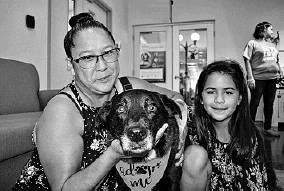EDITORIAL
It’s on us to save pets
Local shelters need donations, volunteers and people willing to adopt; we owe it to animals.
In late June, sun beating down, people stood in line outside the Harris County Animal Shelter waiting to surrender their pets or turn in a stray. The shelter was overwhelmed, the Chronicle reported, with more than 500 animals packed into a space that can comfortably hold 200. As the line crawled along, some people lost their patience and left animals tied to trees or in boxes in the parking lot.
That’s nobody’s idea of a sanctuary — which is what animal shelters were meant to be when they started in New York City about 150 years ago. After a rabies scare led the city to put a nickel bounty on dogs, officials would round up animals, put them in cages and drown them in the East River, Julie Castle, CEO of Best Friends Animal Society, an animal advocacy group, told the editorial board last week.
“The public went berserk and demanded something that was humane,” she said. “So, we started building shelters around the country and did the same thing, but behind closed doors.”
It’s not quite the same thing, but Castle’s point is well taken: Even today’s animal shelters struggle to provide the kind of care that most of us would deem humane.
No time of year is more challenging than summer, when kitten and puppy populations tend to be at their largest. At BARC, the city of Houston shelter, more than 100 cats and dogs per day are being dropped off at a facility that has about 550 kennels.
A national event Saturday, Clear the Shelters, helped get hundreds of pets adopted around the region, which led to a more relaxed scene Monday at BARC, as Fatima Reyes looked on while a German shepherd named Gio gently played with her 2-year-old daughter.
At least for a day, numbers at the shelter were manageable. But tomorrow, another 100 cats and dogs will be dropped off and shelter workers will once again scramble to find their furry charges, such as Gio, a home. For too many shelter animals in Texas, there is no happy ending.
Texas leads the nation in the number of cats and dogs killed. In 2018, out of 661,000 animals that entered shelters, 114,000 were put down. Only California came close, with 111,000 euthanized out of 715,000, according to a recent report by Best Friends.
The good news is that things are improving, and places such as Harris County and Houston are examples of how communities and governments can step up and give as many pets as possible a chance at survival.
At its peak in the 1980s, American shelters were killing about 17 million cats and dogs, according to Castle. After decades of efforts by animal rights groups and no-kill advocates, that number is down to 733,000. It’s taken a long time for attitudes to change, but once they do, the results can be seen almost immediately.
Even just afew years ago, the Harris County Shelter had an abysmal save rate — the number of animals going in compared with those coming out. In 2012, out of about 26,000 animals brought to the shelter, 22,000 were put down — a save rate of 15.5 percent. Last year, that number was almost 90 percent. At BARC, the save rate seven years ago was less than 10 percent, said Greg Damianoff, who heads the shelter. The save rate for fiscal year 2019 was 86.6 percent.
That’s impressive when you consider that Houston’s climate gives animals a yearlong breeding season and the city’s bayous provide water and food sources. Houston’s relatively transient population means education efforts for pet owners need to be constant as new people come and go, officials said.
Unlike private shelters or rescue groups, municipal shelters such as BARC and Harris County are required to accept any animal brought in.
While both shelters would welcome additional funding, the impact of smart policies is also key. Those include targeted spay and neuter efforts, open adoption policies and trap-neuter-release programs for cats. The shelters also partner with local and national rescue groups to take animals and help find them homes.
Some pets will still be euthanized, officials said, including those that are severely injured, sick, aggressive or infected with rabies.
But for the majority, ending up in a shelter needn’t be a death sentence. All it requires is vigilance and help from the community. Shelter officials say they need donations, volunteers and people willing to adopt and foster animals. Even sharing posts about adoptable pets on social media can make a difference.
Our love for animals is one of the few uniting, nonpartisan issues we have left. Let’s rally around the animals in our communities who need help — especially in the hot summer months — and give them the second chance they deserve.
